Reduced mux structure
The heterogeneous nature of modern network structures has made it necessary that all type of signals like PDH and ATM signals are transported over the SDH network. Some of the telecom hierarchies adopted around the different parts of the world are tabulated (see table on previous page). The process of matching the signals to the network is called mapping, and these tributary signals are mapped with an SDH system in a defined fashion. The container is the basic package unit for tributary channels. The STM-1 frame structure allocates 260×9 = 2340 octets for a container with signal carrying capacity of 260×9×8×8000 (149.76Mbps). This carrying capacity is sufficient for transporting a 139.264Mbps tributary signal (E4–European digital hierarchy). Practically, a special container (C-n) is provided for each PDH tributary signal (Fig. 2). These containers are always much larger than the payload to be transported, and the remaining capacity is used partly for justification (stuffing) in order to equalise out-timing inaccuracies in the PDH signals. Where synchronous tributaries are mapped, fixed fill bytes are inserted instead of justification bytes.
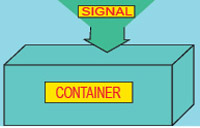
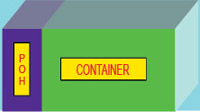
A virtual container (VC-n) is made up from the container, thus formed together with the path overhead (POH) (Fig. 3). The virtual container carried in an STM-1 frame is referred to as a virtual container level four, or VC-4, and is transported unchanged over a path through the network. The channel capacity of VC-4 is 261 x 9 x 8 x 8000 = 150.34Mbps. The VC-4 signal’s carrying capacity can also be subdivided to permit the transport of multiple lower-level PDH signals.
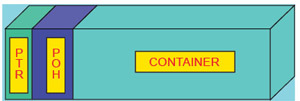

The next step towards the formation of a complete STM-N signal is the addition of a pointer indicating the start of the POH. A pointer is an indicator whose value defines the frame offset of a VC with respect to the frame reference of the transport entity on which it is supported. The unit formed by the pointer and the virtual container is called a tributary unit (TU-n) or an administrative unit (AU-n), and provides adaptation between lower- and higher-order path layers for TU or between higher-order path layer and section layer for AU (Fig. 4). The administrative unit is shaped if a pointer is allocated to the VC formed at the end. Tributary unit structures are classified as TU-11, TU-12, TU-2 and TU-3. All these TUs have different carrying capacities. For example, TU-11 is made up of three columns of nine bytes, resulting in an information carrying capacity of 3x9x8x8000 = 1.728Mbps. TU-12 is structured as four columns of nine bytes, yielding in-transport capacity of 4x9x8x8000 = 2.304Mbps. TU-2 frame is made up of 12 columns of nine bytes and can carry 12x9x8x8000 = 6.912Mbps. Similarly, TU-3 is made up of 86 columns of nine bytes that leads to a transport capacity of 86x9x8x8000 = 49.54Mbps.
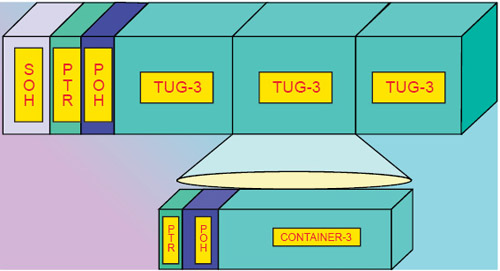
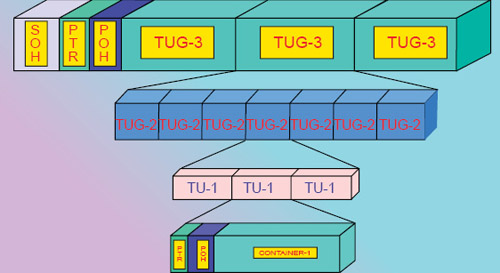
Several TUs taken together form a tributary unit group (TUG-n), which are in turn collected together into a VC. The TUG combines several TUs for a new VC. One or more AUs form an administrative unit group (AUG). Finally, the AUG plus the section overhead (SOH) forms the STM-N. Figs 5 through 7 clearly illustrate the formation of STM-1 from C-4, C-3 and C-1, respectively.
SDH multiplexing hierarchy
A summary of the mappings that are currently possible according to ITU-T recommendation, G.707, and the ATM mapping recommendations are shown in Fig. 8. The hierarchy illustrates all possible multiplex levels, like ATM, European and North American PDH multiplex levels. Other tributary signals can also be accommodated at various multiplex levels, depending on the required capacity. The SDH multiplexing approach is very flexible and allows several paths to build the various signal structures, like STM-1, STM-4, STM-16, STM-64 and STM-256. Of interest in this context is the so-called sub-STM or STM-0 signal. The STM-0 bit rate is 51.84Mbps. This interface is used in SDH/SONET (synchronous optical network) links, radio links and satellite connections.
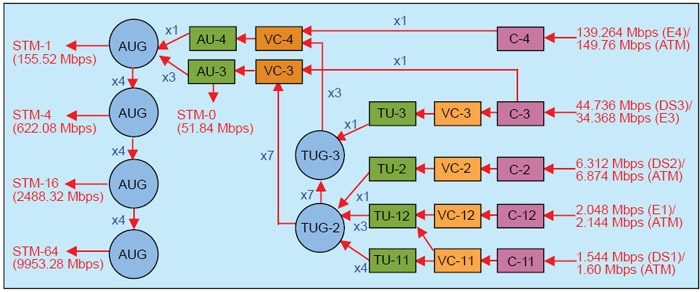
For generating an STM-1 signal, multiplex paths to be followed are:
1. Each E1 signal is mapped into a VC-12, which is then added with a pointer to form a TU-12.
2. Each group of three TU-12 is combined to obtain a TUG-2 (each TUG-2 carrying three E1).
3. Seven TUG-2 are combined to obtain one TUG-3 (each TUG-3 carrying 21 E1).
4. Three VC-3 are grouped to make one VC-4 (each VC-4 carrying 63 E1).
The STM-1 signal carries one VC-4. In order to generate an STM-N signal, several AUG are combined. In order to meet the continually increasing bandwidth requirement, methods have been developed for transmitting the payload in a multiple (n) C-4 (virtual or contiguous concatenation). As an example, a quadruple C-4 can be transmitted in a STM-4.
Conclusion
SDH is a promising transmission technology that can offer very high bandwidth capabilities with the use of synchronous multiplexing techniques. It has proven to be the solution for various high-bandwidth demanding services like video-on-demand, online gaming, video conferencing, etc. It can handle even earlier digital transmission standards, such as E1, PDH or ATM networking, making SDH an all-purpose transport system. With scope for further improvement in the current SDH by incorporating link capacity adjustment scheme, resilient packet ring, virtual concatenation, next generation SDH, it is expected that SDH technology will continue to grow at a tremendous rate well into the next decade and beyond.
The author holds a PhD in electronics engineering from IIT, Varanasi. His current research interests include wired and wireless technologies for high-speed Internet access






